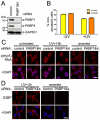Nuclear relocalisation of cytoplasmic poly(A)-binding proteins PABP1 and PABP4 in response to UV irradiation reveals mRNA-dependent export of metazoan PABPs
- PMID: 21940797
- PMCID: PMC3178455
- DOI: 10.1242/jcs.087692
Nuclear relocalisation of cytoplasmic poly(A)-binding proteins PABP1 and PABP4 in response to UV irradiation reveals mRNA-dependent export of metazoan PABPs
Abstract
Poly(A)-binding protein 1 (PABP1) has a fundamental role in the regulation of mRNA translation and stability, both of which are crucial for a wide variety of cellular processes. Although generally a diffuse cytoplasmic protein, it can be found in discrete foci such as stress and neuronal granules. Mammals encode several additional cytoplasmic PABPs that remain poorly characterised, and with the exception of PABP4, appear to be restricted in their expression to a small number of cell types. We have found that PABP4, similarly to PABP1, is a diffusely cytoplasmic protein that can be localised to stress granules. However, UV exposure unexpectedly relocalised both proteins to the nucleus. Nuclear relocalisation of PABPs was accompanied by a reduction in protein synthesis but was not linked to apoptosis. In examining the mechanism of PABP relocalisation, we found that it was related to a change in the distribution of poly(A) RNA within cells. Further investigation revealed that this change in RNA distribution was not affected by PABP knockdown but that perturbations that block mRNA export recapitulate PABP relocalisation. Our results support a model in which nuclear export of PABPs is dependent on ongoing mRNA export, and that a block in this process following UV exposure leads to accumulation of cytoplasmic PABPs in the nucleus. These data also provide mechanistic insight into reports that transcriptional inhibitors and expression of certain viral proteins cause relocation of PABP to the nucleus.
@ 2011. Published by The Company of Biologists Ltd
Figures






Similar articles
-
Depletion of nuclear poly(A) binding protein PABPN1 produces a compensatory response by cytoplasmic PABP4 and PABP5 in cultured human cells.PLoS One. 2012;7(12):e53036. doi: 10.1371/journal.pone.0053036. Epub 2012 Dec 31. PLoS One. 2012. PMID: 23300856 Free PMC article.
-
Poly(A)-binding proteins are functionally distinct and have essential roles during vertebrate development.Proc Natl Acad Sci U S A. 2011 May 10;108(19):7844-9. doi: 10.1073/pnas.1017664108. Epub 2011 Apr 25. Proc Natl Acad Sci U S A. 2011. PMID: 21518916 Free PMC article.
-
Poly(A)-binding proteins and mRNA localization: who rules the roost?Biochem Soc Trans. 2015 Dec;43(6):1277-84. doi: 10.1042/BST20150171. Biochem Soc Trans. 2015. PMID: 26614673 Review.
-
Crossing the borders: poly(A)-binding proteins working on both sides of the fence.RNA Biol. 2010 May-Jun;7(3):291-5. doi: 10.4161/rna.7.3.11649. Epub 2010 May 27. RNA Biol. 2010. PMID: 20400847 Review.
-
Human PABP binds AU-rich RNA via RNA-binding domains 3 and 4.Eur J Biochem. 2004 Jan;271(2):450-7. doi: 10.1046/j.1432-1033.2003.03945.x. Eur J Biochem. 2004. PMID: 14717712
Cited by
-
Cell adhesion-induced transient interaction of ADAM15 with poly(A) binding protein at the cell membrane colocalizes with mRNA translation.PLoS One. 2018 Sep 28;13(9):e0203847. doi: 10.1371/journal.pone.0203847. eCollection 2018. PLoS One. 2018. PMID: 30265671 Free PMC article.
-
The interaction of cytoplasmic poly(A)-binding protein with eukaryotic initiation factor 4G suppresses nonsense-mediated mRNA decay.RNA. 2014 Oct;20(10):1579-92. doi: 10.1261/rna.044933.114. Epub 2014 Aug 21. RNA. 2014. PMID: 25147240 Free PMC article.
-
An integrated model for the nucleo-cytoplasmic transport of cytoplasmic poly(A)-binding proteins.Commun Integr Biol. 2012 May 1;5(3):243-7. doi: 10.4161/cib.19347. Commun Integr Biol. 2012. PMID: 22896784 Free PMC article.
-
Depletion of nuclear poly(A) binding protein PABPN1 produces a compensatory response by cytoplasmic PABP4 and PABP5 in cultured human cells.PLoS One. 2012;7(12):e53036. doi: 10.1371/journal.pone.0053036. Epub 2012 Dec 31. PLoS One. 2012. PMID: 23300856 Free PMC article.
-
Polyadenylated RNA and RNA-Binding Proteins Exhibit Unique Response to Hyperosmotic Stress.Front Cell Dev Biol. 2021 Dec 14;9:809859. doi: 10.3389/fcell.2021.809859. eCollection 2021. Front Cell Dev Biol. 2021. PMID: 34970554 Free PMC article.
References
-
- Afonina E., Stauber R., Pavlakis G. N. (1998). The human poly(A)-binding protein 1 shuttles between the nucleus and the cytoplasm. J. Biol. Chem. 273, 13015-13021 - PubMed
-
- Albrecht M., Lengauer T. (2004). Survey on the PABC recognition motif PAM2. Biochem. Biophys. Res. Commun. 316, 129-138 - PubMed
-
- Anderson P., Kedersha N. (2009). RNA granules: post-transcriptional and epigenetic modulators of gene expression. Nat. Rev. Mol. Cell Biol. 10, 430-436 - PubMed
-
- Batista L. F., Kaina B., Meneghini R., Menck C. F. (2009). How DNA lesions are turned into powerful killing structures: insights from UV-induced apoptosis. Mutat. Res. 681, 197-208 - PubMed
Publication types
MeSH terms
Substances
Grants and funding
LinkOut - more resources
Full Text Sources
Molecular Biology Databases
Research Materials

